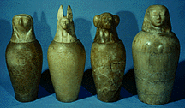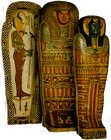When
you think of a mummy what comes to mind?
Most of us usually picture an Egyptian mummy wrapped in
bandages and buried deep inside a pyramid. While the
Egyptian ones are the most famous, mummies have been found
in many places throughout the world, from Greenland to China
to the Andes Mountains of South America.
A
mummy is the body of a person (or an animal) that has been
preserved after death. Normally when we die,
bacteria and other germs eat away at the soft tissues (such
as skin and muscles) leaving only the bones behind. Since
bacteria need water in order to grow, mummification usually
happens if the body dries out quickly after death. The body
may then be so well preserved that we can even tell how the
dead person may have looked in life.

Mummies
are made naturally or by embalming, which is any process
that people use to help preserve a dead body.
Mummies can be dried out by extreme cold, by the sun, by
smoke, or using chemicals such as natron. Some bodies become
mummies because there were favorable natural conditions when
they died. Others were preserved and buried with great care.
The
ancient Egyptians believed that mummifying a person's body
after death was essential to ensure a safe passage to the
afterlife.
Mummification
in ancient Egypt was a very long and expensive process.
From start to finish, it took about seventy days to embalm a
body. Since the Egyptians believed that mummification was
essential for passage to the afterlife, people were
mummified and buried as well as they could possibly afford.
High-ranking officials, priests and other nobles who had
served the pharaoh and his queen had fairly elaborate
burials.

The
pharaohs, who were believed to become gods when they died,
had the most magnificent burials of all. In the
case of a royal or noble burial, the embalmers set up
workshops near the tomb of the mummy.
The
art of Egyptian mummification consisted of many steps.
First, the body was washed and ritually purified. The next
step was to remove the deceased person's inner organs.
A slit was cut into the left side of the body so that the
embalmers could remove the intestines, the liver, the
stomach and the lungs. Each of these organs was embalmed
using natron, which served to dry out the organs and
discourage bacteria from decaying the tissues.
The
organs were then individually wrapped using long strips of
linen and placed in canopic jars. The lids of these
jars were fashioned after the four sons of Horus, who were
each entrusted with protecting a particular organ.
|
Canopic
jars with lids depicting the four sons of Horus:
Qebehsenuef, the falcon head --
intestines
Duamutef, the jackal head --
stomach
Hapy, the baboon head -- lungs
Imsety, the human head -- liver
|

Kelsey
Museum of Archeology
|
After
the removal of the inner organs, the body cavity was stuffed
with natron. The brain was then removed through the
nose using long hooks. Since the ancient Egyptians
considered the brain unimportant, it was probably thrown
away.
The
body was then placed on a slanted embalming table and
completely covered with natron. This allowed fluids
to drip away as the body slowly dried out. This part of the
process took about forty days, after which the natron was
removed, inside and out, to reveal a dried, shrunken body.
After another cleaning, the body was rubbed with unguents to
aid in preserving the mummy's skin. The head and body cavity
were stuffed with packing.

The
mummy was then prepared for bandaging. First, the
embalming cut in the side of the body was sewn up and
covered with a patching depicting the protective eye of
Horus. The body was adorned with gold, jewels and protective
amulets. Fingers and toes were covered with protective gold
caps and individually wrapped with long, narrow strips of
linen. Arms and legs were also wrapped, then the entire body
was wrapped to a depth of about twenty layers. The embalmers
used resin to glue the layers of wrappings together. The
wrapped head was covered with a mummy mask. Finally, the
last layer of bandages went on and was given one last
coating of resin. The mummy was the ready for burial.
Once
the mummy was finally prepared, it was time for the funeral.
The mummy and its canopic jars were transported by sled from
the embalming tent to the tomb. People were hired to
demonstrate their grief by crying and throwing dust on their
hair. At the site of the tomb, religious ceremonies were
held to prepare the dead for the afterlife. In particular,
the Opening of the Mouth ceremony was believed to allow the
mummy to see, hear, eat and drink in the spirit world.






